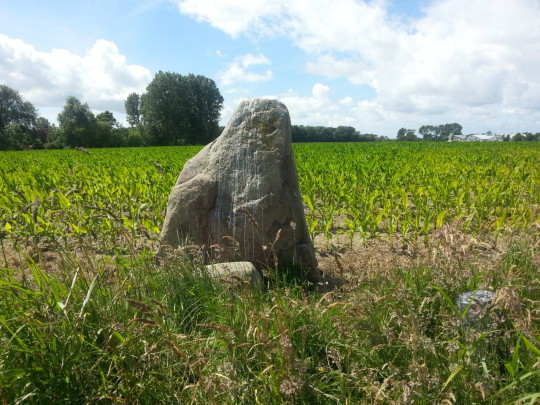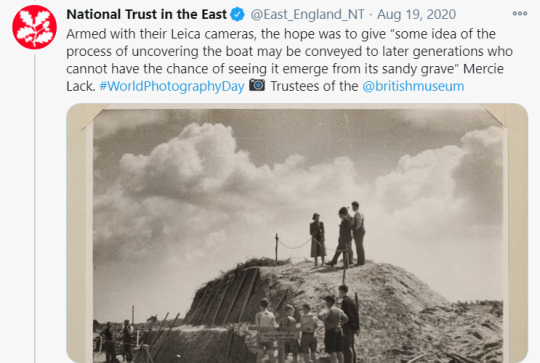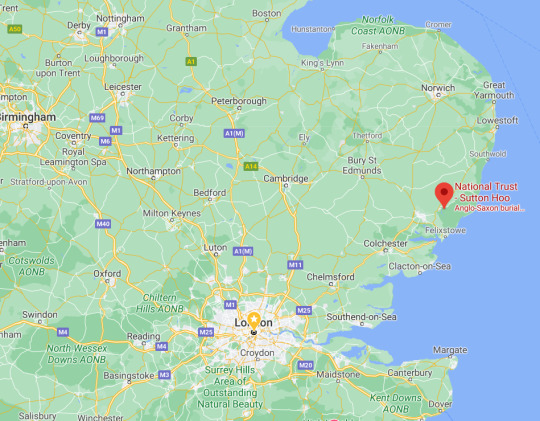#in the 1990s viking treasure was found on this land as well
Photo

Westerklief, the Netherlands
Westerklief became known for the "stien." This large boulder dates from the Neolithic period and is one of the largest from this period. It was said to turn when it heard the church bell toll. Children were told not to pull silly faces because when "the dog barks, the bell tolls and the stone spins around, your face will remain forever so!"
#in the 1990s viking treasure was found on this land as well#westerklief#holland#the netherlands#oer#neolithic#wieringen#wieringermeer#history#viking#ancient land#fields
111 notes
·
View notes
Text
Wednesday 20th January 2021
History from Long Ago and a Bit of Nature Thrown In
See Update edit at the end of this blog*
Another dark day here, absolutely bogging as we might say. Wet and uninviting. There’s no way I want to venture into the great outdoors despite the younger Nature Watch flagging up this helpful article.
So instead, I’ve stayed snug indoors and embarked upon a history lesson. Settle down as you could lose an afternoon on this one. I do apologise for rambling on so much, but it was one of those that once you started, you I just couldn’t stop.

For obvious reasons photos today are not my own but are credited to the sites linked
On an historic day in American history, when a woman takes a presidential role for the first time, I’ve been focusing on women.
The question is do you know anything about Edith Pretty?

Edith Pretty (1883-1942) photo credit: National Trust
This is she.
Now I very much doubt that Edith Pretty is a name that springs to many people’s mind? but if it wasn’t for her, it seems Britain would have been denied one of its greatest national treasure collections.
I started off looking at Edith and her story at Sutton Hoo because I was looking into another little known but hugely influential woman who made an impact on natural history, with barely any recognition at the time and then I got side-tracked by news of The Dig, a new Netflix film, out at the end of this month - the 29th to be precise. Now I’m not a big film fan, but this tells the intriguing true story of how a wealthy and idiosyncratic widow with a ferocious sense of civic duty, lead an archaeological excavation just before the outbreak of World War II (1939-1945)
Just what I want on these horrid Winter evenings, history and mystery.
Edith had a very privileged background and travelled extensively with family in her youth, not just pleasure trips but educational journeys far and wide. The family were interested in ancient sites and antiquities and this stayed with Edith.
When she married at the age of 42 she purchased a marital home and estate named Sutton Hoo*in South East Suffolk. Frank and Edith went on to have a son born when Edith was 47, but sadly Frank only lived until the boy was four years old, after which it’s possible that Edith became more and more interested in spirituality and lives that had gone before.
Sutton Hoo derives its name from Old English. Sut combined with tun means the southern "farmstead" or "settlement" and Hoh refers to a hill "shaped like a heel spur" Wikipedia
* when the Tranmer family Trustees later donated the house to the National Trust, it was renamed Tranmer House
There’s a far longer and more involved tale than I can unravel here. It started with curiosity, hunches and investigations into some strange mounds of earth in the grounds, with the help of Basil Brown. Brown, who Edith was introduced to via acquaintances, was a self-taught archaeologist with an interest in astronomy.
The mounds of earth had undoubtedly been the subject of investigation by grave robbers centuries before, but fortuitously, they’d not gone far enough to make any significant finds and the land continued to lay undisturbed. It’s incredible to think that before the qualified experts became involved, the first excavations took place using household items such as penknives, pastry brushes and bellows. The whole wonderful significance of such an impressive discovery and the way it came about, is fairly earth shattering.
Basil and Edith’s project uncovered the shape and remains of a ship which was at first thought to be Viking, but later determined to almost certainly be a burial chamber marking the death of an Anglo-Saxon king. Interred with it were many priceless, perfectly preserved gold and silver jewelled and highly decorated artefacts from the early 7th century and before. These treasures had been gathered from far and wide; the products of breathtakingly deft workmanship, which, even today, with precision tools and artificial lighting, cannot be matched easily. Some of the items seem, to me, reminiscent of Fabergé’s finest.

A gold shoulder clasp decorated with garnet and glass cloissoné
Image credit National Geographic
Cloisonné is the technique of creating designs on metal vessels with coloured glass paste. This is placed within enclosures made of copper or bronze wires, bent or hammered into the desired pattern. Known as cloisons (French for “partitions”), the enclosures generally are either pasted or soldered onto the metal body. The glass paste, or enamel, is coloured with metallic oxide and painted into the contained areas of the design. The vessel is usually fired at a relatively low temperature, about 800°C. Enamels commonly shrink after firing, and the process is repeated several times to fill in the designs. Once this process is complete, the surface of the vessel is rubbed until the edges of the cloisons are visible. They are then gilded, often on the edges, in the interior, and on the base
The collection of 263 objects included weapons, silver cutlery, gold buckles, coins, and a distinctive full-face helmet, of a kind never before recovered in Britain.

The purse lid on this Link is photographed from various angles and the standard of the materials, design and workmanship is just mind boggling, as is the condition of something which was crafted in the 7th Century.

Bronze Washing Pot decorated with glass and enamel. The hooks are to hang it up. Image credits National Geographic
Two other women who played a key role in documenting the investigation were Mercie Lack and Barbara Wagstaff. People I hadn’t heard of either. They were both schoolteachers who had a passion for photography and for Anglo-Saxon archaeology. As friends they had previously spent school holidays photographing carved stone for the British Museum and they brought their skills to bear on recording the early days of the Sutton Hoo excavation. They likely responded to a public appeal for photographers to help out and turned the Summer break into a holiday stay as well. Their images, many of them neatly annotated, provide a fascinating insight into the project, and include some of the earliest colour photographs from an archaeological investigation in this country. Of all the volunteers their work was the most professional.

Image credit: National Trust, Twitter
The National Trust has undertaken a project to digitalise this collection and preserve it for posterity.
Unfortunately, as is often the way, in the dramatisation the film follows the book upon which it is based, where the author chose to replace them with a fictional (male) character. Like Edith, Mercie also bequeathed her artefacts from the dig to the British Museum. You’d really liked to have thought that the women’s contributions were recognised and noted and not airbrushed out of the story.
Incredibly, after a treasure trove inquest (August 1939 at Sutton Parish Hall) it was determined that the astounding find - which would entirely revolutionise historians’ understanding of the Anglo-Saxons - belonged not to the Crown but to the landowner and extraordinarily Edith donated the entire haul to the nation.
In 1951, having been stored in Aldwych Tube station during the war, it went on display in the British Museum - albeit with no credit, not a single namecheck, for Basil Brown. Sadly, Edith was no longer around to object. Basil was almost 90 when he died in 1977, but after suffering a blood clot on the brain, she had died in 1942, aged just 59.
Winston Churchill had offered Edith a CBE in recognition of her extraordinary generosity, but she declined the honour, almost certainly on the basis, according to Laura Howarth, archaeology manager for the National Trust, that she had ‘merely been doing her duty’
Laura Howarth says ‘There have been notable Anglo-Saxon finds since, but nothing like this, a fully furnished, undisturbed ship burial. We know of only three Anglo-Saxon ship burials, two at Sutton Hoo and one near by at Snape. So it was a very localised practice’

Wikipedia Link Sutton Hoo
TIMELINE:
1926
Edith Pretty buys the site of Sutton Hoo, and becomes fascinated by the strange mounds of earth on her land.
1939
Basil Brown discovers a funerary cache of 263 objects in tumulus 1. World War II breaks out in September.
1946
After being kept safe underground during the war, the treasure—owned by the British Museum—is put on public display.
1990s
Further excavations uncover another intact burial site in tumulus 17 containing a young man, a horse, and weapons.
The British Museum link to Edith and to the treasures

Photo: Harold John Phillips in the public domain. The ‘skeleton’ of the almost 90′ Ghost Ship imprint in the soil. This size ship would have accommodated 40 oarsmen
There’s also a piece about recreating the ‘Ghost Ship’ on this Daily Mail link and it has a good piece of National Trust video showing the site.
Rebuilding the Ship and why use Green Oak?
The Ship’s Company Team is a group of people with the collective desire to resurrect King Raedwald’s burial ship and turn the famous ghost imprint into a living reality.
Although there is no evidence left to examine the identity of the illustrious occupant of the burial ship, a strong guess is that it was possibly King Raedwald? It certainly must’ve been someone fabulously wealthy and highly regarded. The Sutton Hoo sword video from the British Museum at the end of this blog is very well worth a watch, exploring more about the man.
Within the ship, archaeologists found various treasures from across both the British Isles as well as the Byzantine (eastern Roman) and Frankish (western European) empires — including the famed Sutton Hoo helmet.
The grave itself is thought to belong to King Rædwald of East Anglia, a member of the Wuffingas dynasty which has been associated with the Wulfing clan of Sweden, who appeared in the Old English epic poem Beowulf.
If you’d like to read more and see some absolutely fabulous original photographs do go over to this Anonymous Blog. Edith was the cousin of the author’s Great Grandmother and it is a really personal and detailed account of what the family know of this incredible lady. I highly recommend it.
So there we are, you can see how I became utterly absorbed and went from internet site to site following all the history. I’m really interested in catching the film and seeing how the whole story of the people and the discovery is portrayed. Remember the date 29th January, if you have access to Netflix.
*UPDATE:
Please do read this blog about Basil Brown, written by John Cooper
youtube
WHAT ELSE DID I LEARN TODAY:
The Seventh Century covers the years 601-700 and I picked out this fact
Only one woman has ever sat on China's throne as Emperor in her own right. That woman was Wu Zetian (624-705) of the Tang dynasty
0 notes